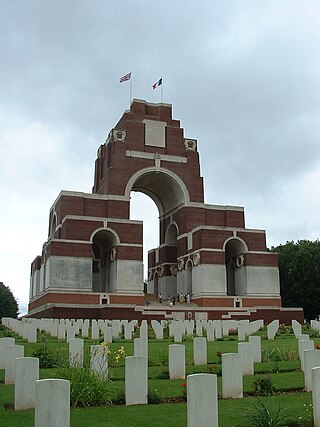
The Thiepval Memorial to the Missing of the Somme is a war memorial to 72,337 missing British and South African servicemen who died in the Battles of the Somme of the First World War between 1915 and 1918, with no known grave. It is near the village of Thiepval, Picardy in France. A visitors' centre opened in 2004. Designed by Sir Edwin Lutyens, Thiepval has been described as "the greatest executed British work of monumental architecture of the twentieth century".

Samuel Forsyth, VC was a New Zealand recipient of the Victoria Cross (VC), the highest award for gallantry in the face of the enemy that could be awarded at the time to British and Commonwealth forces.
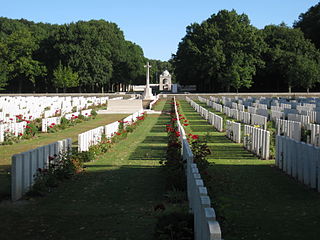
Delville Wood Cemetery is a Commonwealth War Graves Commission cemetery located near Longueval, France and the third largest in the Somme battlefield area.
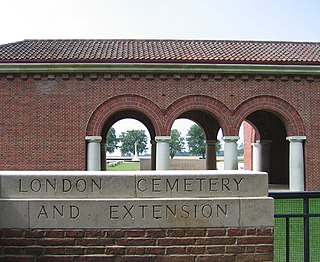
The London Cemetery and Extension is a Commonwealth War Graves Commission cemetery at High Wood near Longueval, France. It is the third largest of the Somme battlefield cemeteries, containing 3,872 World War I burials.

The Capture of Regina Trench was a tactical incident in 1916 during the Battle of the Somme during the First World War. Regina Trench was the Canadian name for a German trench dug along the north-facing slope of a ridge running from north-west of the village of Le Sars, south-westwards to Stuff Redoubt, close to the German fortifications at Thiepval. It was the longest such German trench on the Western Front. Attacked several times by the Canadian Corps during the Battle of the Ancre Heights, the 5th Canadian Brigade of the 2nd Canadian Division briefly controlled a section of the trench on 1 October but was repulsed by counter-attacks of the German Marine Brigade, which had been brought from the Belgian coast. On 8 October, attacks by the 1st Canadian Division and the 3rd Canadian Division on Regina Trench also failed.

The Pozières Memorial is a World War I memorial, located near the commune of Pozières, in the Somme department of France, and unveiled in August 1930. It lists the names of 14,657 British and South African soldiers of the Fifth and Fourth Armies with no known grave who were killed between 21 March 1918 and 7 August 1918, during the German advance known as the Spring Offensive, and the period of Allied consolidation and recovery that followed. The final date is determined by the start of the period known as the Advance to Victory on 8 August.

The Buttes New British Cemetery Memorial is a World War I memorial, located in Buttes New British Cemetery, near the town of Zonnebeke, Belgium. It commemorates 378 officers and men of the New Zealand Division who were killed in the vicinity and have no known grave.

The 25th Battalion, CEF was a unit in the Canadian Expeditionary Force during the Great War. It was the second infantry battalion of ten to be raised in Nova Scotia during the war. The 25th served in Belgium and France as part of the 5th Canadian Brigade, 2nd Canadian Division from 16 September 1915 until the end of the war. Regimental headquarters were established at the Halifax Armouries, with recruitment offices in Sydney, Amherst, New Glasgow, Truro and Yarmouth. Of the 1000 Nova Scotians that started with the battalion, after the first year of fighting, 100 were left in the battalion, while 900 men were killed, taken prisoner, missing or injured.
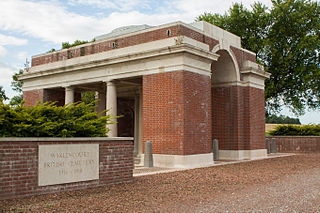
Warlencourt British Cemetery is a Commonwealth War Graves Commission burial ground for military personnel who died on the Western Front during the First World War. It is located in the Pas de Calais region of France. Established in 1919 to consolidate several smaller cemeteries, it was designed by Sir Edward Lutyens and is administered by the Commonwealth War Graves Commission. There are 3,450 soldiers interred, over which 1,823 are unidentified. There are also memorials to 55 soldiers whose graves are unknown. The majority of the soldiers who have been identified are British, with smaller numbers of Australians, South Africans, New Zealanders, and Canadians.

AIF Burial Ground is a Commonwealth War Graves Commission burial ground for the dead of the First World War located near Flers on the Somme in France.
Bancourt British Cemetery is a Commonwealth War Graves Commission burial ground for the dead of the First World War located in the Pas de Calais region of France, on the Western Front.

Abbeville Communal Cemetery is a Commonwealth War Graves Commission burial ground for the dead of the First World War and Second World War located near Abbeville, in the Somme department of France. It is adjacent to the Abbeville Communal Cemetery Extension.
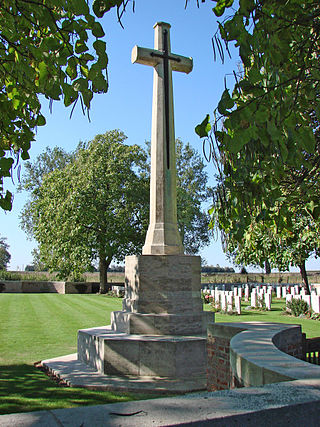
Foncquevillers Military Cemetery is a Commonwealth War Graves Commission burial ground for military personnel who died on the Western Front during the First World War. It is located in the Pas de Calais region of France. Originally established in 1915 by the French military for its soldiers, it was later used for British personnel. Designed by Sir Reginald Blomfield and administered by the Commonwealth War Graves Commission, there are 648 soldiers of the First World War interred in the cemetery with 53 of them unidentified. Another four graves are for German soldiers of the First World War, while five Canadian airmen who died in the Second World War and a French civilian are also buried in the cemetery.

Dantzig Alley British Cemetery is a Commonwealth War Graves Commission burial ground for the dead of the First World War. It is located near the village of Mametz, eight kilometres from Albert in the Somme department of France.

The Bulls Road Cemetery is a military cemetery located in the Somme region of France commemorating British and Commonwealth soldiers who fought in the Battle of the Somme in World War I. The cemetery contains mostly those who died manning the front line near the village of Flers between September 1916 and March 1917 and between March 1918 and September 1918. The cemetery is managed by the Commonwealth War Graves Commission.

The Cerisy-Gailly Military Cemetery is a military cemetery located in the Somme region of France commemorating British and Commonwealth soldiers who fought in World War I. The cemetery contains mainly those who died on the front line near the village of Cerisy between February 1917 and March 1918 and during the Allied recapture of the village in August 1918.

The Combles Communal Commonwealth War Graves Commission Cemetery Extension is a military cemetery located in the Somme region of France commemorating British and Commonwealth soldiers who fought in the Battle of the Somme in World War I. The cemetery contains mainly those who died near the village of Combles between October 1916 and March 1917 and between May and September 1918.















